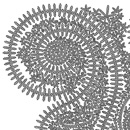


 |
 |
 |
 |
Toshiya Tsunoda
“Ridge of Undulation”
Häpna H.24, CD
8 tracks, 39 minutes
|
|
Listen to: “At Stern, Tokyo Bay_11 Dec 97”
Reviews of “Ridge of Undulation” Release date: December 13, 2005 |
|
|
“The vibration of a thin metal plate and the huge waves of a vast seashore... similar phases can be observed between them... like wrinkles on clothes remind us of mountain ridges.”
New release from Japanese Toshiya Tsunoda who was the first artist to be released on Häpna in 1999. This household name in the art of fieldrecordings has produced a discography of highly sublime recordings capturing the finest details of sound, and Ridge of Undulation is no exception. This new work is exploring sonic phenomena of very different magnitudes, from roaring waves at sea to experiments with high frequency sine waves and vibrating objects. Piezoceramic sensors were placed on the objects and the vibrations were transmitted in voltage, which can be recorded. Toshiya Tsunoda is a Yokohama based artist who has studied at the Tokyo National University of Fine Art and Music. Tsunoda is concerned with the relation between sound space and cognition space and the hidden beauty in the tiniest sonic details. Since 1994, he has been operating the WrK label, which he co-founded with Minoru Sato. He has previously released works on the WrK, Selektion, Lucky Kitchen, Staalplaat and Häpna labels. His work has been shown at the ICC, Tokyo, and the Kawasaki city museum, among others. Tracks: 1. Sine waves mixed with the sound of a vibrating surface_1, 2. Seashore, Venice beach_31 Jul 01, 3. An aluminum plate with low frequencies_1, 4. Metal pieces with high frequencies, 5. At stern, Tokyo Bay_11 Dec 97, 6. Arrival, Kisarazu bay_11 Dec 97, 7. An aluminum plate with low frequencies_2, 8. Sine waves mixed with the sound of a vibrating surface_2 |
|
|
---------------------------------------------------------------
|
|
|
Reviews
|
|
|
“For his second offering on Hapna, Toshiya Tsunoda offers up eight environmentally controlled compositions based on two primary elements: field recordings and studio juxtapositions. The first method appears three times, mainly near bodies of water in the United States and Tsunoda's home in Japan. The second method makes up the rest of the album, using sine waves and frequencies mixed with vibrating objects to produce sounds that, while different in delivery, are strikingly similar in tone and texture. Many of these experimental combinations result in drones that subtly shift and offer faint melodies when listened to attentively.”
Rated 4/5, Rob Theakston, All Music Guide “Toshiya Tsunoda has long been revered for his meticulously detailed recordings of acoustic phenomena both in field or natural settings and in constructed atmospheres. Tsunoda’s particular interest is in how acoustic forms mutate either in contact with closed resonance chambers or with various editing techniques. Often the outcome of these experiments is that structure present in the original sound source is echoed in larger resonant areas. Because of this echoing of structure at different scales, it is tempting to employ a fractal metaphor to describe Tsunoda’s output. However, this is not exactly apt because fractals are mathematical formulae that reproduce structure recursively, in the absence of external stimuli. They are self-contained, not interactive. “ On the topic of whether sound artist Jeph Jerman's Hands To was "music," he replied to one EMF Institute interviewer, “[...] The first is the second release on their by Toshiya Tsunoda, who is also responsible for the first release on the label in 1999. Tsunoda works field recordings as-well as music dealing with sound in relation to space. On this new CD there are various examples of this, such as the eight times layered sine waves in the opening and closing pieces of the CD. In between there are three pieces of field recordings. Here they are presented untreated (as usual). Tsunoda knows where to put a microphone and how to make a field recording that is interesting to hear and not 'just' a field recording. Three further pieces on this CD deal with aluminum plates and vibrating objects, picked by piezoceramic sensors to make the vibrations audible. In all eight pieces Tsunoda explores sound phenomena, but it's explorations that are interesting to hear, not just for the sake of exploring. Three different approaches for Tsunoda on one disc, that is something odd. Usually he explores one idea per release (just field recordings, just vibrations), so in that respect this is something of a 'best of' or perhaps 'an introduction'. In any case it's probably the most varied work of Tsunoda so far. In case you need a place to start: here it is.” |
|